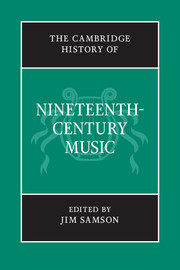Book contents
- Frontmatter
- Part One 1800–1850
- Part Two 1850–1900
- 11 Progress, modernity and the concept of an avant-garde
- 12 Music as ideal: the aesthetics of autonomy
- 13 The structures of musical life
- 14 Opera and music drama
- 15 Beethoven reception: the symphonic tradition
- 16 Words and music in Germany and France
- 17 Chamber music and piano
- 18 Choral culture and the regeneration of the organ
- 19 Music and social class
- 20 Nations and nationalism
- 21 Styles and languages around the turn of the century
- Chronology
- Institutions
- Personalia
- Index
- References
19 - Music and social class
from Part Two - 1850–1900
Published online by Cambridge University Press: 28 March 2008
- Frontmatter
- Part One 1800–1850
- Part Two 1850–1900
- 11 Progress, modernity and the concept of an avant-garde
- 12 Music as ideal: the aesthetics of autonomy
- 13 The structures of musical life
- 14 Opera and music drama
- 15 Beethoven reception: the symphonic tradition
- 16 Words and music in Germany and France
- 17 Chamber music and piano
- 18 Choral culture and the regeneration of the organ
- 19 Music and social class
- 20 Nations and nationalism
- 21 Styles and languages around the turn of the century
- Chronology
- Institutions
- Personalia
- Index
- References
Summary
A chapter of this size cannot provide much more than an overview of music and class in four major cities (London, Paris, New York and Vienna), but will focus on detail whenever this illustrates the broader argument or reveals developments of particular interest. In the second half of the nineteenth century features of musical life associated with a capitalist economy and the consolidation of power of a wealthy industrial bourgeoisie became firmly established. Prominent among such features were the commercialisation and professionalisation of music, new markets for cultural goods, the bourgeoisie’s struggle for cultural domination and a growing rift between art and entertainment.
Presented below is a study of music and class in four cities, not four countries. Nevertheless, these were the major commercial cities of those countries, home to the wealthiest commercial families. In each, there was rapid population growth and the creation of a large market for entertainment. The power wielded by the upper class began to weaken earlier in Paris than in London, and was slowest to give way in Vienna where the bourgeoisie mingled least with the aristocracy. In New York, there were no inherited titles, of course, although the ‘upper ten’ of that city were often disposed to define themselves against the European aristocracy and, at mid-century, were perceived to be not dissimilar to the upper classes of Paris’s Faubourg St Germain or London’s West End. Paris and Vienna both underwent major reconstruction in the second half of the century. Napoleon III instructed Haussmann to redesign Paris following the 1848 Revolution, and the result was a city of wide arterial boulevards and symmetrical layouts.
- Type
- Chapter
- Information
- The Cambridge History of Nineteenth-Century Music , pp. 544 - 567Publisher: Cambridge University PressPrint publication year: 2001
References
- 2
- Cited by



